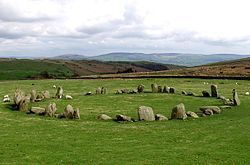




Isles in Albion*
We know essentially nothing about the activities of the Isles haplogroups after they ended up on the shore of Britain, but we do know about the culture as a whole.
7,000 y.a. __Farming was introduced into England and the megalith "religion" came to Britain and took a strong foothold. It took about 2,000 years for farming to be fully accepted across England. Farming produced more food in a seasonal pattern, which left time for things like building stone circle megaliths.
6,700 y.a. __ Isles A - Y12072 branched off Isles AB, probably along the Thames or in East Anglia.
4,800 y.a. __Mt. Pleasant henge was constructed.
4,700 y.a. __The people of the Bell Beaker Culture, including Isles B, began migrating to Britain
4,300 y.a. __Eruption of Hekla 4 (VEI 4) in Iceland. "Ireland was thirty years waste".
4,000 y.a. __Copper mining in Cork and tin mining in Cornwall to make bronze
3,645 y.a. __�1627 BC events� [29] Volcanic eruptions of Hekla 3 and Mt. Thera (Santorini)
3,000 y.a. __Eruption of Hekla 3 (VEI 5) in Iceland. There was an 18 year long temperature drop.
The TMRCA of the unfortunate Isles A is only 950 years. Another, or probably several, major population bottlenecks had ocurred. It is suspected that the Bell Beaker invasion, the volcanic weather events, the plagues, the Anglo-Saxon invasions and just plain bad luck were the causes.
7,000 y.a. __Farming was introduced into England and the megalith "religion" came to Britain and took a strong foothold. It took about 2,000 years for farming to be fully accepted across England. Farming produced more food in a seasonal pattern, which left time for things like building stone circle megaliths.
6,700 y.a. __ Isles A - Y12072 branched off Isles AB, probably along the Thames or in East Anglia.
Isles A produced not a single surviving branch for 3,700 years. This is indicative of a hostile environment keeping them on the edge of5,000 y.a. __Construction began at Stonehengeextinction the entire time.
Stonehenge 
The Windmill Hill culture, who were perhaps an "East Anglian tribe", began construction of the immense Stonehenge complex and the other nearby sites: Woodhenge, Durrington Walls henge, and the connecting pathways, etc.5,000 y.a. __Bell Beaker folk arrive in the Rhine delta.
Isles A was perhaps a very minor participant.
4,800 y.a. __Mt. Pleasant henge was constructed.
4,700 y.a. __The people of the Bell Beaker Culture, including Isles B, began migrating to Britain
Their arrival was catastrophic for all the Y haplogroups already living in Britain. The Beaker culture came with superior metal weapons, archery, armor, cavalry, horses and wagons. The mesolithic defenses of the indigenous groups were powerless against them.4,500 y.a. __The Bronze Age began in Britain brought by the Bell Beaker folk
The Beaker folk were mainly haplogroup R1b, but they had many others mixed into the tribes. Isles B constituted perhaps 2% of the group.
There was nearly a 97% replacement of the indigenous haplogroups, mainly haplogroup I subclades, by the R1b invaders. However, the mitochondrial haplogroups didn't change all that much. This allows two interpretations as to whether it was just a displacement, keeping the women and chasing all the men off to the west, or a more extreme 'ethnic cleansing'. There is evidence for both and there is much disagreement.
Isles A survived almost exclusively in Cork. From there a few have migrated to Isle of Man, Scotland, Wiltshire, and the rest of Ireland and Great Britain.
Most of the Isles B who had been on the continent came to Britain with this invasion. More came later with the Anglo-Saxon invasions around 500 AD. This spread Isles B fairly evenly over all of Britain and Ireland and left a few on the continent until the present day.
4,300 y.a. __Eruption of Hekla 4 (VEI 4) in Iceland. "Ireland was thirty years waste".
4,000 y.a. __Copper mining in Cork and tin mining in Cornwall to make bronze
3,645 y.a. __�1627 BC events� [29] Volcanic eruptions of Hekla 3 and Mt. Thera (Santorini)
A series of volcanic eruptions from Iceland to Greece produced eight decades of severe climate recognized in Chinese records, Irish bogs, and dendrochronology, 1630-1544 bc, produced the collapse of many civilizations known as the "Bronze Age Collapse".3,600 y.a. __ Isles C founded in Dal Riata and Isles D near Roscommon, Ireland.
3,000 y.a. __Eruption of Hekla 3 (VEI 5) in Iceland. There was an 18 year long temperature drop.
The TMRCA of the unfortunate Isles A is only 950 years. Another, or probably several, major population bottlenecks had ocurred. It is suspected that the Bell Beaker invasion, the volcanic weather events, the plagues, the Anglo-Saxon invasions and just plain bad luck were the causes.
